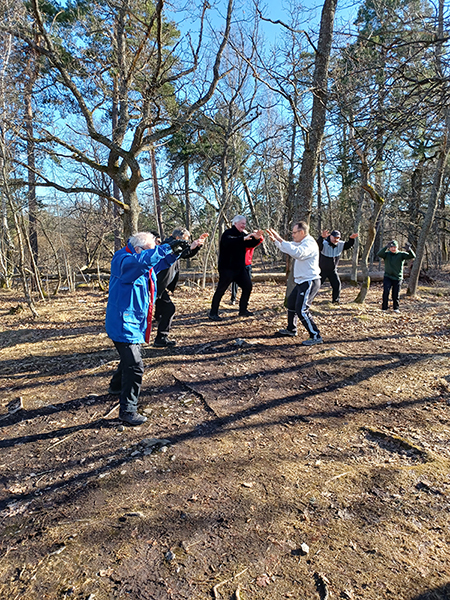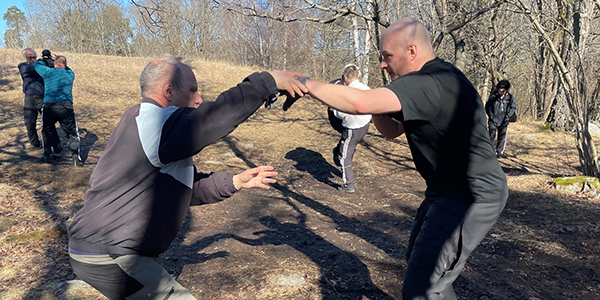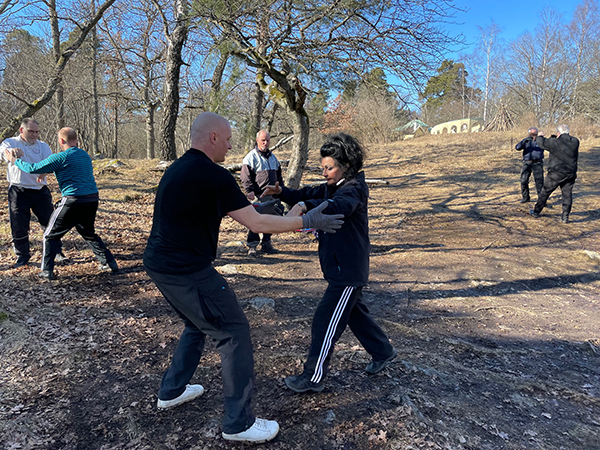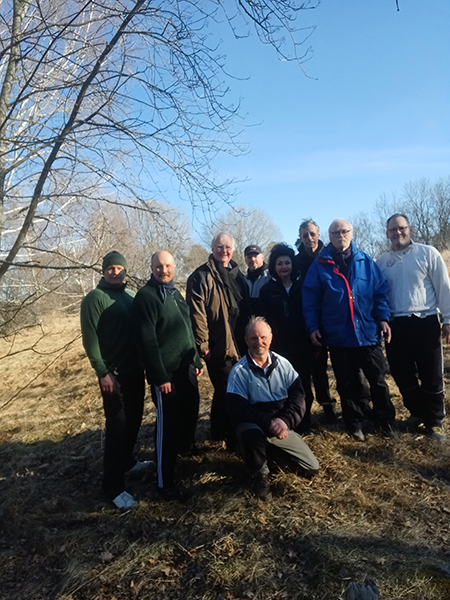
| Seminar and practice photos, Stockholm, 19-20 March 2022 | 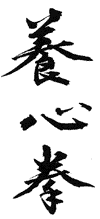 Yoshinken |
||||
Saturday 19th of March
Ritzu-zen Under the lead of Sensei Åke we started the seminar with 70 minutes in Ritzu-zen. After Ritzu-zen followed a very interesting discussion about experiences and different conditions regarding standing in Zen for a longer time. Injuries, wear and tear could limit the possibility to stand in a high Zen Kamae for a longer time. Some of us also have mental difficulties to stand in Zen for a long time. We also talked about the experience of Ki in our Zen training. Regarding this discussion about Ki, my thoughts goes to the book written of Soke Yoshimichi Sato; Kensei Sawai Kenichi Sawai. “No matter how much I try to tell you about Ki, you won’t be able to grasp the true meaning of Ki without practising on your own. Whether you get it lies in your own experience and in your feelings. It depends upon you only. Even if you hear Ki explained thousand times, you will never understand it on the basis of explanations alone. It is something that come from your own strength and from life long practice”.
Yuri As an extension of our Ritzu-zen, Sensei Åke showed us a new type of Yuri than we have performed before. This Yuri was linked to one of Yoshinkens five principles, Teki-yo = application. The intention of the application was to move forward with our arms still and horizontal. The arm movements were executed in the moment when we came in contact with our partners technique. The application of this Yuri was much more faster and concealed In its movement. The performance of this Yuri also make it much more difficult for an attacker to read and feel the intention behind the movement.
Hai Sensei Anders continued to lead the seminar in Hai and Neri. In Taikiken, Hai training developing the protection and safety of our body against one or more opponents. Chinese T’ai-chi philosophy has a classification of the cosmos into three large divisions: Heaven (Ten), Earth (Chi) and Man (Jin). In Hai you develop strength in the hips and in the legs. The arms must act like the antennas of an insect in detecting the kind of attack the opponent intends to make. With the lead of Sensei Anders, with and without a partner, we trained these movements in Hai. We also moved with our arms in three heights.
Neri Zen and Hai developing the Ki inside the body. Neri works the outer parts of the body. Neri means kneading. Four kinds of methods are used in kneading the body into good condition in defence and attack: Mukae-te, Harai-te Sashi-te and Daken. For defence and attack, Sensei Anders gave us many good and funny exercises in kneading our bodies. Saturday evening was ended with good food together in a Chinese restaurant.
Rickard Alvevind
|
Sunday 20th of March
Suishu Sunday morning we were back in Hagaparken and the day started with Sensei Andreas holding a session with the theme Suishu (Pushing hands). First we had to do Suishu two by two and on command freeze in the middle of the movement. This makes it possible to see for your self, if you have a good position and if you have kept your Ritsu Zen, making it a good way to evaluate your posture in Suishu. Then we had to practice different ways to get into our opponent in Suishu by making a spiral movement. The session ended with us, two and two, having to choose an application that we could perform from Suishu. Thereafter, that application was performed as a finish after three laps of Suishu and in free form where first one of the pairs performed the application and then both.
Randori After that, Sensei Åke held a session with Randori as the theme. We had to do an exercise where we gradually went over from Tanshu opposite each other, to Push hands, to Randori and back to Push hands. It was a good way to help us maintain a reasonable intensity in Randorin, where we keept being able to deliver technically good movements with flow and a dynamic change between hard and soft. We also got to do Randori and add the dynamics from the different elements in how we moved. It was an exciting exercise that taught us a lot about varying dynamics and tempo, although some elements were of course easier to achieve than others. Above all, it became difficult when both people in the couple used elements that were very forward, such as wood. It was a pretty interesting conclusion and maybe that's why you can sometimes read about how different elements can be used to neutralize each other. Then we had lunch and Sensei Monika started her lecture already during lunch by summarizing the history of Jodo and telling about some people who have been important in the development of the style.
Bokken After lunch we left for OKK Dojo. Where Senpai Lennart held a session focusing on Bokken. He let us work with different series of techniques, including two different ways of drawing the sword, followed by cutting and a thrust. We also got to build a similar series our self and perform it in pairs two and two.
Jo The day ended with a session on Jo led by Sensei Monika. Here we went through the basic Jo techniques. We also got, each one, to describe the techniques and what details are important to think about. The fact that we in OKK's dojo had access to mirrors also meant that we later, when we practiced the techniques, could get direct feedback on exactly the details that Sensei Monika asked us to look at. We also made a form of Push hands / Sticky hands with Jo. Two and two we first did three rounds of contact and then at the end immediately slipped into an application. Finally, we did an exercise with Bokken and Jo where the one with Jo stick knocked Ukes Bokken away in different ways.
Andreas
|
||||
|
|||||
